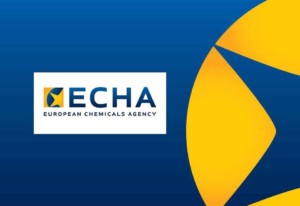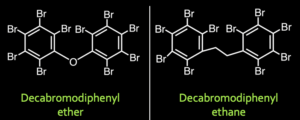January 2020: The New Year delivers...
In this edition:
- Flame Retardant Dilemma and Beyond 2020
- Our Institute Petitions EPA to Regulate PFAS as Hazardous Wastes
- European Reforms Rally behind Class Concept
- Regrettable Substitutions in our Bodies
- CALENDAR

We’re now just weeks away from our annual symposium, the Flame Retardant and PFAS Dilemma. You are invited to join us on Feb. 7 at UC Berkeley for this important and fun event. Since 2007, these annual symposia have educated decision-makers about harmful chemicals and led to better policy and purchasing to protect public health. More information is below. Register HERE.
Also, I’ll be speaking about both mountain climbing and local PFAS drinking water contamination in Spokane, Washington next Wednesday. You can read the excellent article in the local paper by clicking the image above.
We rang in the new year with notable progress on PFAS “forever chemicals.” The 2020 National Defense Authorization Act–the military budget–was signed into law on December 20, 2019. Despite opposition from the President, it contains important provisions to reduce harm from PFAS contaminating the drinking water of millions of Americans. Groundbreaking changes include nationwide water testing for PFAS by the U.S. Geological Survey and a phaseout of PFAS in military firefighting foam.
“Just a few years ago achieving these critical protections, especially the foam phaseout at military bases, seemed impossible,” our scientist Tom Bruton told Bloomberg News. You can learn more in my interview with KOMO News.
And today we joined five PFAS-contaminated communities in petitioning the EPA to regulate PFAS chemicals as hazardous wastes. Until the chemicals are listed as hazardous under federal law, these communities and hundreds more–maybe yours–will not receive the clean-up assistance and other help they need. You can read the press release for our petition here, and an excellent blog by Claudia Polsky of Berkeley Law here.
The new year also sees two important new California policies on flame retardants go into effect. As of January 1, 2020, the California Building and Residential Codes allow below-grade use of foam plastic building insulation without flame retardants. We have worked for this important change for a decade. Also going into effect is California Assembly Bill 2998, which bans the use of most flame retardants in children’s products, upholstered furniture, and mattress foam.
And it looks like federal furniture regulations might finally follow the path of the Golden State. If passed, the bipartisan SOFFA Act (House Resolution 2647) will adopt California’s Technical Bulletin 117-2013 (which obviates the need for flame retardants in furniture) for the whole nation. You can read more about how this bill would improve our country’s health and safety in this blog by NRDC’s Avi Kar.
Finally, we have open positions here at the Institute in Berkeley for a manager and for an executive assistant. Contact [email protected] if you might be interested or have suggestions.
Best wishes for a Happy New Year,
Arlene and the Green Science Policy team
Flame Retardant Dilemma and Beyond 2020

Please join the Green Science Policy Institute and scientists and advocates working to reduce the use of toxics at the annual Flame Retardant and PFAS Dilemma.
Since 2007, these meetings have educated decision-makers in government and business to reduce toxics and protect our health. Register HERE.
When: Friday, Feb. 7, 2020, 8:30 AM to 4:00 PM
Where: Banatao Auditorium, 330 Sutardja Dai Hall, UC Berkeley (2594 Hearst Ave., Berkeley, CA)
Contact: [email protected]
Cost: $10 students; $25 non-profit, government, academia etc; $50 corporate & business. (Costs cover the venue, continental breakfast, lunch, & snacks.)
Register: HERE.
We hope you can join us for this fun and educational symposium. The agenda can be found here. This year’s inspiring speakers include:
- Jared Blumenfeld (Secretary for Environmental Protection, State of California) will present his vision for a Healthy Environment in California.
- Malene Teller Blume (COOP Denmark) will tell how a retailer helped Denmark become the first country to ban the use of PFAS in paperboard food packaging.
- Tony Spaniola (Need Our Water (NOW)) will share the dramatic story of his father’s work against flame retardant contamination in Michigan in the 1970s and how he continues this legacy with PFAS.
- Graham Peaslee (University of Notre Dame) will explain the risks of PFAS and flame retardants to firefighters.
Our Institute Petitions EPA to Regulate PFAS as Hazardous Wastes
by Tom Bruton

What can be done to help communities whose drinking water has long been contaminated by PFAS? And how do we prevent more communities from falling victim to this problem?Along with our partners at the UC Berkeley Environmental Law Clinic and community groups from Alaska to North
Carolina, today we petitioned the U.S. EPA for a policy solution to both problems. Our petition demands the
agency list hundreds of PFAS as hazardous wastes under the federal Resource Conservation and Recovery Act (RCRA).
RCRA is the statute that governs the management of hazardous wastes to minimize pollution. Designating these chemicals as RCRA hazardous wastes would make them subject to strict storage, transfer, and disposal requirements ‘from cradle to grave’- thus preventing more contamination. RCRA listing would also automatically designate these chemicals as hazardous substances under the federal Superfund law, unlocking clean-up dollars to address already-contaminated sites.
Our co-petitioners are five PFAS-contaminated communities: Alaska Community Action on Toxics, Buxmont Coalition for Safer Water in Pennsylvania, Clean Cape Fear in North Carolina, Fountain Valley Clean Water Coalition in Colorado, and Michigan PFAS Alliance. The UC Berkeley Environmental Law Clinic worked with us to develop and submit the petition. You can read a related petition submitted by Public Employees for Environmental Responsibility (PEER) in September here.
“RCRA listing is a two-fer,” says law clinic Director Claudia Polsky. “It will ensure safer management of PFAS wastes, and will make it easier to hold polluters accountable for cleaning up PFAS-polluted sites.”
“We teach our children at an early age: if you make a mess, clean it up,” said Hope Grosse and Joanne Stanton, co founders of the Buxmont Coalition for Safer Water in Pennsylvania. “The same goes for polluters, even the military. By listing PFAS as hazardous wastes under RCRA, this petition will make polluters accountable for
cleaning up.”
See the full petition HERE.
European Reforms Rally behind Class Concept
by Joe Charbonnet

European legislative committee dialogues may sound dull compared to the present political theater in the U.S., but December was action-packed for safer chemistry rules in the EU. In an address to European Parliament’s Environment Committee (watch the full remarks here), the European Chemicals Agency’s (ECHA) director announced that the agency will start looking at substances in groups, rather than one-at-a-time. This move makes ECHA the largest regulatory agency in the world to adopt the class concept, and positions it well to prevent harm from regrettable substitutions. ECHA has long endorsed the scientific principles underlying grouping chemicals by class, so it is encouraging to see the science inform smart policy.
The European Commission also unveiled its Green Deal last month. This flagship initiative will include legislation on chemicals in consumer products, with an emphasis on very persistent chemicals and endocrine disrupting chemicals.
However, some groups pointed out that the plan could do more to explicitly address the role of toxic chemicals in the circular economy. The Environmental Citizens Organisation for Standardisation published an action plan for the Green Deal to address toxic chemicals that limit the recyclability of our products. Compounds like flame retardants not only threaten our health, they can taint materials so they are only fit for landfill. A restriction has already been placed on organohalogens in electronics cases to ensure their recyclability. The headlines may not be as splashy across the pond, but strong chemicals policies show European leaders are making big news.
Regrettable Substitutions in our Bodies
by Anna Soehl

Another frustrating edition of chemical whack-a-mole is unfolding in our bodies. A recent peer-reviewed study of Chinese adults from a manufacturing area concludes that exposure to deca-ethane (aka decabromodiphenyl ethane or DBDPE), a popular replacement for deca-ether (aka decabrominated diphenyl ether or BDE-209), is associated with changes in thyroid activity and therefore this chemical might be an endocrine disrupter. This finding is alarming as deca-ethane has become widely used in electronics, furniture, and toys.
Another recent study measured these and other brominated flame retardants in the breast milk of first-time Irish mothers. The researchers found that while restrictions on penta- and octa-BDEs have resulted in reduced human exposure, body burdens of deca-ether are yet to decline. Levels of deca-ethane, which were not detected in breast milk in 2011, are now starting to show up too.
Given that the structures of deca-ethane and deca-ether are almost identical, this is a classic example of a regrettable substitution and demonstrates why the class concept is so useful.
And evidence is building that organophosphate flame retardants-another common replacement for PBDEs-are just as problematic. A new scientific article found that these chemicals are associated with harm to brain development, reproductive problems, and asthma in children. This study builds on our own recent review of the scientific literature which found that organophosphates share many concerns with PBDEs but need similar policy changes.
Given what we already know about the dangers associated with many flame retardants, manufacturers should use creative design solutions and inherently fire-resistant materials instead of continuing the cycle of replacing one harmful chemical with another similarly toxic one.
To learn more about this toxic class of chemicals and for tips on how to reduce your
family’s exposure to flame retardants, watch our four-minute video here.
CALENDAR
February 7, 2020: Flame Retardant and PFAS Dilemma, Berkeley, CA
Our annual meeting brings together scientists, business, government, and citizens’ groups to share information on PFAS, flame retardants, and other chemicals of concern.
- When: February 7, 2020, 8:30am-4:00pm
- Where: Banatao Aud., Sutardja Dai Hall, UC Berkeley (2594 Hearst, Berkeley, CA)
- Information: [email protected]
- Register: here. For more information, contact [email protected].
January 21, 2020: Spokane Mountaineers Event, Spokane, WA
Our Executive Director Arlene Blum will present “Breaking Trail: Mountains and Molecules” to the Spokane Mountaineers
- When: 7:00pm
- Where: Centerplace Event Center, 2426 N Discovery Pl, Spokane Valley, WA 99216
- For more information, contact Li Ciavola at [email protected].
March 6, 2020: UC Davis AgChem Colloquium, Davis, CA
Arlene Blum will present a keynote talk for UC Davis AgChem Colloquium
- When: 4:00pm
- Where:Plant and Environmental Sciences Building (PES), Room 3001, Agriculture
and Environmental Chemistry, University of California, Davis, CA(2594 Hearst, Berkeley, CA)
March 31, 2020: Sustainable Packaging Coalition Impact 2020, Austin, Texas
Tom Bruton will present on PFAS and food packaging.
- When: 9:30am
- Where: AT&T Hotel & Conference Center, Austin, TX
March 24, 2020, Green Labs Summit, St. Louis, Missouri
Arlene Blum will give a keynote. The intent of the Summit is to bring together scientists, manufacturers, sustainability professionals, and others to envision a truly sustainable future.
- Where: MilliporeSigma, 2909 Laclede Avenue, St. Louis, MO
April 1, 2020: CWEA PFAS Summit, Reno, Nevada
Arlene Blum will keynote the PFAS Summit at California Water Environment Association (CWEA) Annual Conference. Her talk is entitled: “PFAS: What It is, What It Comes From, Where It’s Found and Its Dangers”
- When: 10:00am
- Where: Reno-Sparks Convention Center, Reno, NV
April 4, 2020: Global Health and Innovation Conference. New Haven, CT
Tom Bruton will present on the Six Classes at Unite for Sight’s 17th annual Global Health & Innovation Conference.
- Where: Yale University, New Haven, CT
Receive Updates By Email
Subscribe to our monthly newsletter and get these updates delivered right to your inbox!